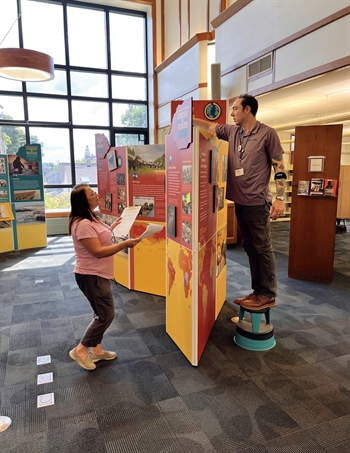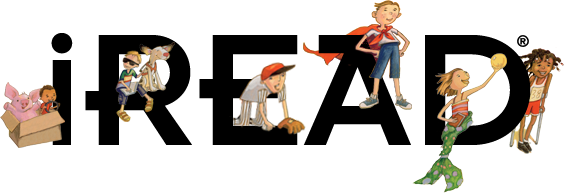June 2025 | Volume XLIII, Issue 2 »
World on the Move: Exhibit at the Glen Ellyn Public Library
June 2, 2025
Joshua O'Shea, Glen Ellyn Public Library
Where did we come from? Where are we going? How does migration change us? These three big-picture questions appear on the larger-than-life displays of World on the Move: 250,000 Years of Human Migration from the American Anthropological Association, the Smithsonian Institution, and the American Library Association.

The World on the Move exhibit stopped in Illinois at the Glen Ellyn Public Library (GEPL) from July 22, 2024, to August 31, 2024. It consisted of six modules standing about 10 feet high in various shapes displaying high-contrast images from around the globe. Fifteen people, including library staff and community volunteers, set up the exhibit over two mornings. At the end, five staff members broke the exhibit down over two days and repacked it. World on the Move focuses on four locations called Crossroads (the Mediterranean Basin, Beringia, Central Africa, and East Los Angeles), which serve as case studies, demonstrating the depth of culture, development, change, and connections with the people groups who pass through or settle in each location. The term crossroad implies that no geographic location is isolated from influence from other places; all cultures or groups are connected through time and space. Movement doesn’t stop; each person is part of a story of a group that came from another location and will themselves move or have successors who migrate, whether generational movement, short-distance travel, or trans-continental emigration.
Glen Ellyn Public Library was the only Illinois library to host the exhibit. Significant factors in this decision included the area’s immigration-focused organizations, the library’s proximity to the Metra line, and the space available for the exhibit: we have a large, vaulted atrium that is perfect for exhibits and performances.
The creators of World on the Move intended to spark curiosity and conversations about the intersections of ethnicity, place, and reasons for moving. Taking intention as our guide, our library developed a slate of programs for all ages for our summer programs.
We organized over 25 unique programs connected to World on the Move concepts. For example, local advocacy group Exodus World Service provided immigration simulations where patrons could move between stations in a way that echoes how new migrants feel coming to the United States. Chef Walks First from Ketapanen Kitchen of Chicago led the Sample the Foods of Turtle Island event to provide samples of Indigenous foods. Reality Illinois, the Teen Advisory Panel to the DuPage County Health Department, and I, the Young Adult Librarian at GEPL, led a program called Empathy is Your Superpower to learn how developing empathy can build self-esteem, foster community, and deepen connections. David Ouellette, Associate Professor of Art History at College of DuPage, presented The Illustrated Popol Vuh: A Mayan Creation Story. For the children, local author Shirin Shamsi discussed her book The Moon from Dehradun, which is based on her family’s migration from India to Pakistan.
From November 2023 to June 2024, in the lead-up to and organization of the exhibit, I conducted extensive outreach to surrounding organizations for assistance in promotion. Select Adult Department staff also built a slate of participation opportunities. The two most popular programs were VIP Tours and Volunteer Docents. Many of the groups who had hosted my outreach efforts took advantage of the VIP Tours, including staff from other libraries, churches, social justice action groups, the League of Women voters, and county service departments.
For the VIP Tour, groups around Glen Ellyn could schedule a tour with the library Board President and myself to get behind-the-scenes stories and refreshments during a one-hour tour. Tour groups met in a gathering room before the official event to interact with other groups scheduled at the same time, enjoy refreshments, hear the story of how the exhibit came to the library, what it was like to build the exhibit, and how we built programs around it. Even though the tour’s official time frame was one hour, attendees, called tourists during the experience, often stayed to talk, socialize, and re-read the exhibit well past the 60 minutes, sharing migration stories from their own lives or in their family trees.
The Volunteer Docent program gave everyone from high school students to retired adults a chance to get involved. I was responsible for communicating with and training the volunteers, along with designing software with guides and content for docents to be knowledgeable hosts. Docents had orientation and training sessions describing the activities and principles of the position. They helped watch over the exhibit material, noting damage or locations that seemed popular with people who came to look. Docents collected, recorded, and replaced sticky notes from the interactive portion of the exhibit, which enabled tourists to answer questions posed by the exhibit regarding migration experiences. Each docent was encouraged to complete an “empathy essay” that compared their perspectives on the various subjects of the exhibit before and after they volunteered.
Docents did not need to be experts in the subjects; they focused on having a friendly face that could explain the exhibit’s layout and draw attention to the Understanding Migration website. Docent training enabled them to be self-sufficient, build their schedule, and be independent of the desk staff. The Docent Supervisor communicated with docents, suggested improvements to docent activities, and co-led many VIP tours; this role was vital to ensure docent support. While designed for anyone, volunteer or library staff, our Docent Supervisor ended up being one of our board members. Volunteering as a docent was another way to involve high school and college students when school was not in session, indirectly fulfilling the vision of the World on the Move makers who wanted to connect with teenage students. Adults became docents, too; social justice groups, civic engagement groups, and individuals who wanted to learn and “give back” were part of the docent team.
The program that required the most staff involvement, the longest-running event, and the most diversified experience was making World on the Move our Summer Reading theme. We had branded staff t-shirts, activity goals that counted as program achievements, travel-themed prizes for all ages, and partnered with a local organization called Ten Thousand Villages. Ten Thousand Villages focuses on fair trade commerce, simplifying the connection between creators and customers, and the international functionality matching the World on the Move character. We marched in the village Independence Day Parade, went on outreach, gave Storytimes in the Park, and handed out chocolate bars for registration throughout the summer months with the exhibit logo and promotional materials. We hosted Movement of Desis: Desi-Fusion Dance Collective–Chicago to kick off the program. Later in the summer, we hosted celebration dances from West African and Polish American groups while a Taco Madre food truck and Sunset Slush frozen treats stand were available.
The exhibit resonated with the Glen Ellyn Village administration and residents. In 2020, the Village subcommittee One Community facilitated Community Conversations about diversity, equity, and inclusion for residents that continued over the next few years. These conversations aimed to help residents discuss their experiences of living in Glen Ellyn with entities and concepts such as schools, police departments, tax structures, social services, and civic holiday celebrations, and to gather ideas for elevating and enriching those experiences. Various institutions contracted Native American instructors to craft land acknowledgments with Trickster Cultural Center of Schaumburg and Midwest SOARRING Foundation of Lockport. Local groups created a neighborhood watch network to provide free supplies to people moved by buses from Texas who were then dropped at the local Metra railway station. The library connected with local government commissions, educators from the nearby community college, and other educational and service-based groups to build information-sharing networks and programs.
Check out the website UnderstandingMigration.org for more information about the exhibit, including tour stops and content, as well as for an ecosystem of academic articles, sound clips, and supplemental classroom material from a host of expert creators.
I want to highlight a few people. Em Gallaugher and Brian Russell, who are on the team overseeing the exhibit at the Public Programs Office of ALA Chicago, prepared us before arrival and evaluated our library’s integrated programs and outreach. Maggie Thomann was the department head who found and attained the exhibit and supported my efforts. Dawn Bussey is the Executive Director of our library and supported allocating many library resources to make the exhibit and surrounding projects a success.
This was a massive group project from Glen Ellyn Public Library staff and community volunteers; it would not have been possible without them. To see all associated programs and find the library workers who made it happen, go to gepl.LibraryCalendar.com and use the tag World on the Move under Program Type. Collective effort and passion made our endeavors a success.
Humans will always be on the move, and public libraries will always provide resources and welcome to the residents and visitors who come through our doors.

 iREAD Summer Reading Programs
iREAD Summer Reading Programs Latest Library JobLine Listings
Latest Library JobLine Listings